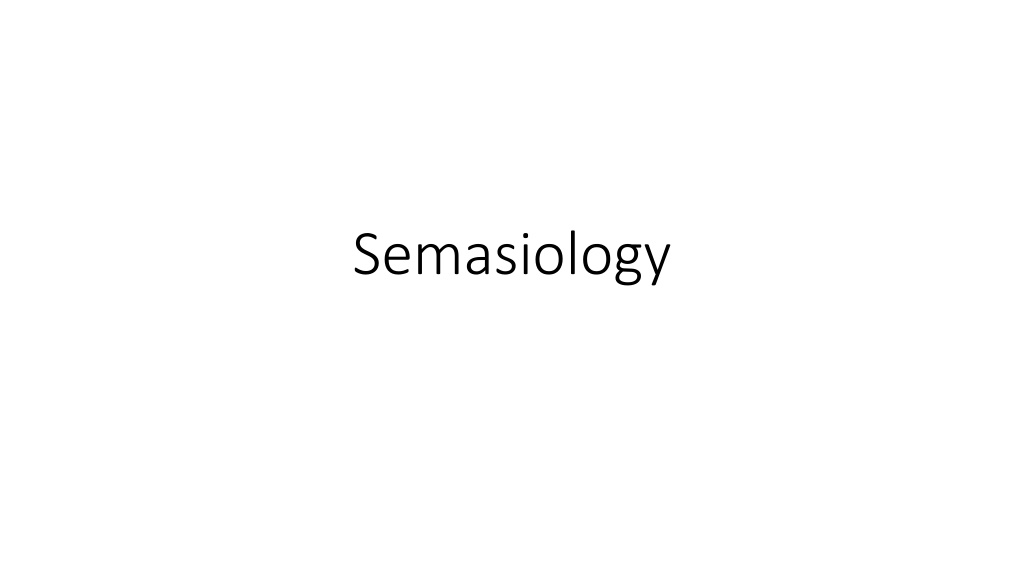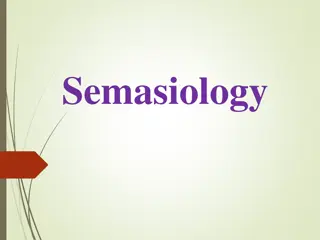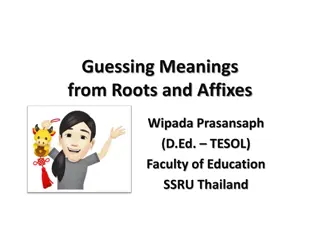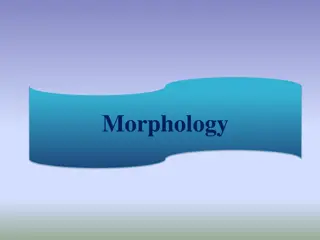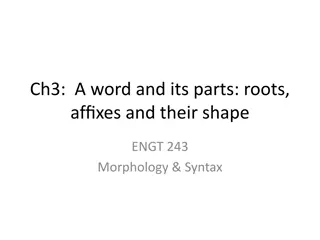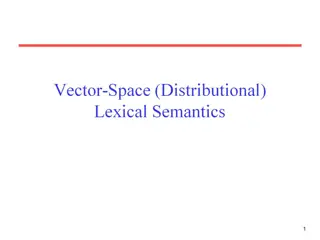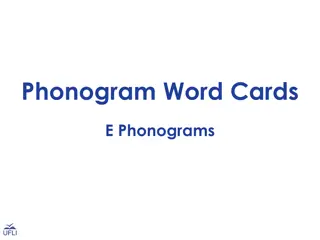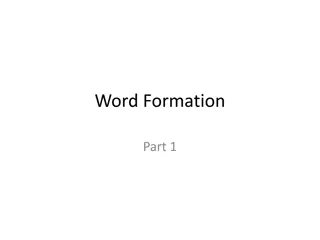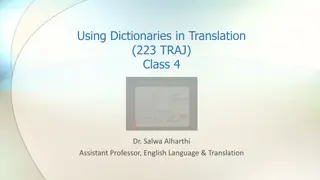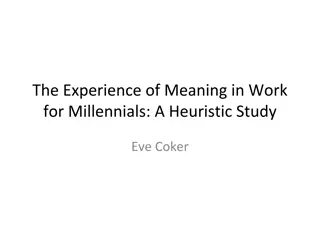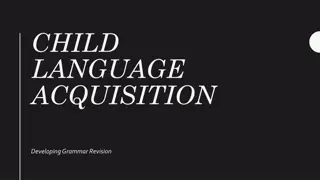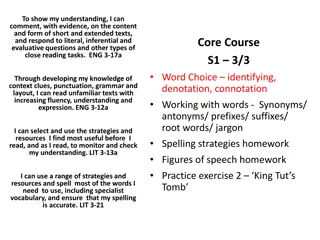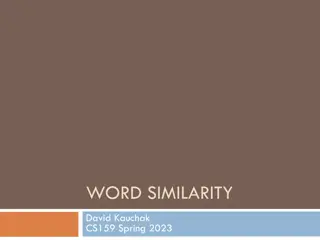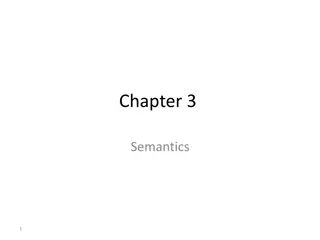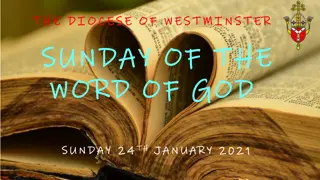Understanding Semasiology: The Study of Word Meaning
Semasiology is a branch of linguistics focused on the meaning of words. It delves into various aspects of lexical meaning, semantic development, polysemy, and semantic structure. Through exploring types of word meanings and semantic changes, semasiology helps us comprehend the intricate nuances of language. The referential model of meaning, including the basic triangle of Reference, Symbol, and Referent, provides insight into the interconnection between words and reality. Different types of word meanings, such as grammatical, lexical, denotational, and connotational, contribute to the richness and depth of language expression.
Download Presentation

Please find below an Image/Link to download the presentation.
The content on the website is provided AS IS for your information and personal use only. It may not be sold, licensed, or shared on other websites without obtaining consent from the author. Download presentation by click this link. If you encounter any issues during the download, it is possible that the publisher has removed the file from their server.
E N D
Presentation Transcript
Outline 1. The Nature of Word Meaning. 2. Types of Word Meaning. 3. Causes, Nature and Results of Semantic Change. 4. Semantic Structure of English Words. Polysemy. 5. Conceptual (Semantic) Field. Hyponymy. 6. Synonymy. Sources of Synonymy. 7. Antonymy. Classification of Antonyms. 8. Homonymy. Classification of Homonyms.
The Nature of Word Meaning. Semasiology is a branch of linguistics which studies the meaning, i.e. semantics of words. The main objects of semasiological study are: types of lexical meaning, semantic development of words, polysemy and semantic structure of words, the change of word-meanings, semantic relations in the vocabulary homonyms, semantic fields, etc.). (synonyms, antonyms,
The Nature of Word Meaning. Meaning is a certain reflection in our mind of objects, phenomena that makes part of the linguistic sign (a word) its inner facet, the sound-form functions as its outer facet A linguistic sign is represented by a three-cornered pattern: concept sign thing (Ferdinand de Saussure) The prominent English scholars C.K. Ogden and I.A. Richards modified de Saussure s three-cornered pattern. They distinguished between the three components closely connected with meaning: the sound form of the linguistic sign, the concept underlying this sound form and the referent, i.e. that part or that aspect of reality to which the linguistic sign refers.
Referential model of meaning The best known referential model of meaning is the so-called basic triangle : Reference (Concept) Symbol (Sound Form) Referent (Object of Reality) The referential approach formulates the essence of meaning by establishing the interdependence between words and things or concepts they denote.
Types of word meaning Grammatical meaning expresses relations between words in speech . Lexical meaning is the realization of concept or emotion by means of a definite language system. Contextual meaning of a word is established in a given context when a word has a special meaning, different from its notion. Denotational meaning is the conceptual content of a word. It denotes things of reference and is considered the component of the lexical meaning. It is the expression of the direct meaning of the word without any emotive evaluation or stylistic coloring. Connotational meaning conveys additional information about the referent containing the speaker s attitude. It is the supplementary expressive meaning: girl girlie maiden; a donkey a foolish person; a calf a young inexperienced person.
Motivation The interrelation between the lexical meaning of the word and its structural pattern is called motivation. Three types of motivation: Phonetical (sound-clusters imitate the sounds they signify: chatter, cuckoo, murmur, splash) Morphological (derived words and non-idiomatic compound words hairdresser (hair + dress + er) = one who cuts or arranges hair ) Semantic (the relationship between the direct and the transferred meaning of the word, e.g. heart of the country, a mother tongue.) The mistaken motivation due to the seemingly analogous form of the borrowings and well-known native words is called (false) folk etymology (cockroach, helpmate).
Types of the lexical meaning of words: 1) Nominative meaning which is the direct meaning of the word, referring to the objects in extralinguistic reality. The nominative meaning comprises two components: denotational and connotational. 2) Syntactically conditioned meaning which is observed in different colligations, e.g. to take smth ( ; ), to take smth from smth ( ), to take smb, smth for smb, smth ( , , ), to take to smb ( , ) 3) Phraseologically bound meaning which is idiomatic and is only observed in some phraseological units, e.g. to talk turkey ; husband s tea ; black frost .
Diachronic approach to the notion of meaning . The direct meaning which is subdivided into: a) the primary (etymological) meaning, e.g. wall (n) < Lat. Vallum fortification; b) the derived meaning, formed out of the primary meaning, e.g. wall an upright side of a building or room; II. The secondary meaning which is subdivided into: a) the secondary denotative meaning, e.g. wall (inside surface of cavity or vessel), e.g. walls of the stomach, vascular walls, reactor wall, diaphragm wall, basement wall, foundation wall; b) the secondary figurative meaning (the referent is named and at the same time characterised through its similarity with other objects), e.g. wall of silence; tough meat (direct meaning) tough politician (figurative meaning).
Causes of semantic changes the changes in social life of a community technological changes scientific development
Semantic changes in denotation lead to: 1) the extension (generalization) of meaning, i.e. the extension of semantic capacity of a word (polysemy) in the process of language development, e.g. manuscript originally meant smth hand-written , now refers to any copy whether written by hand or typed; 2) the narrowing (specialization) of meaning is the restriction of the semantic capacity of a word in the historical development, e.g. bread originally meant a fragment or a small peace , now refers to food made of flour, water, and yeast mixed together and baked ; voyage any trip or journey > a journey by sea or water.
Semantic changes in connotation result in: 1) degradation (the pejorative development of meaning) is the semantic change, by which a word acquires some derogatory emotive charge, e.g. gang a group of people going together > an organized group of criminals ; coarse ordinary, common > rude or vulgar ; 2) elevation (the ameliorative development of meaning) is the semantic change in the word which rises it to a position of greater importance, e.g. knight manservant > a noble courageous man ; minister a servant > a head of a government department .
Metaphoric and metonymic changes Metaphor is a transfer of name based on the association of similarity, likening one thing to another by way of referring to it as if it were some other one. This process leads to the development of the so-called trite metaphors : time flies, a cold look, tail of a plane, face of a clock, back of the chair, foot of the mountain, eye of a needle, etc. In these cases the connection between the original and transferred word meaning is lost. As a result, the secondary figuratively derived meaning may actually become its primary one. Metonymy is a device in which the name of one thing is changed for that of another to which it is related by association of having close relationship to one another, e.g. The marble speaks (the statue made of marble), the best pen (the best writer), a heart of gold (a kind-hearted person), the kettle is boiling (the water is boiling in the kettle)
Semantic structures of words Monosemy is the existence within one word of only one meaning. e.g. monopoly, radar, cybernetics, biochemistry,, audit, broker, etc. Polysemy is a complex of all meanings which a word can have as a result of its development (the main (central) meaning and associated meanings, that become evident in certain lexical and grammatical contexts, e.g. We treated her to coffee. Don t treat animals cruelly. This essay treats the progress of medical science. Semantic diffusion is observed in words with a very wide conceptual volume, e.g. thing, affair, stuff, etc. can name various living beings, facts, inanimate objects, problems, etc.
Classifications of words The semantic field is a sector of the vocabulary characterised by some common concept as the common denominator of their meaning; it is also called a conceptual field, e.g. black, green, yellow the field of colour; joy, passion, sorrow the field of emotions Hyponymy is the semantic relationship of inclusion. The hyponymic relationship may be viewed as the hierarchical relationship between the meaning of the general and individual terms. Hyperonym is a word with a broad meaning constituting a category into which words with more specific meanings fall, e.g. colour is a hyperonym of red . Hyperonym serves to describe the lexico-semantic group. Hyponym is a word of more specific meaning than a general term applicable to it, e.g. spoon is a hyponym of cutlery. e.g. vehicle includes car, bus, tram, taxi, etc. The principle is widely spread in botany (rose, daisy, chrysanthemum, tulip are included in the meaning of flower which functions as the generic term).
Classifications of words Synonyms are words belonging to the same part of speech, differing in sound form, and possessing one or more identical or nearly identical (similar) denotational meaning. Ideographic (relative) synonyms which have different shades of meaning, e.g. beautiful fine handsome pretty Stylistic synonyms which differ in emotive value and stylistic sphere of application, e.g. child (neutral) infant (elevated) kid (colloq) Absolute synonyms, quite alike in their meanings and stylistic coloring, and therefore, interchangeable in all contexts, are very rare, e.g. word-building word-formation; compounding composition
Antonyms a synonymic dominant the sources of synonymy Euphemisms Antonym is a word which means the opposite of another word is called. 1) root antonyms, e.g. long short, up down, to start to finish. 2) affixal antonyms, e.g. hopeful hopeless, happy unhappy, appear disappear.
Homonyms Homonyms are words identical in form but quite different in their meaning and distribution I. Absolute homonyms, e.g. bear ( ) ::bear ( ) II. Partial homonyms: 1) Homographs which are identical in spelling but different in sound, e.g. row [rou] :: row [rau] , wind [wind] i :: wind [waind] . 2) Homophones which are identical in sound but different in spelling, e.g. knight ( ) :: night ( ), air ( ) :: heir ( ).
Reference literature 1. . . . : , 2003. 160 c. 2. . . . : , 2009. 128 3. . ., . . : . : , 2021. 144 . 4. Crystal D. The Cambridge Encyclopedia of the English Language. Cambridge University Press, 1995. 498 p. 5. Kveselevich D.I., Sasina V.P. Modern English Lexicology in Practice. : - . . , 2000. 117 p. 6. Kvetko P. English Lexicology in Theory and Practice. Trnava, 2005. 203 p. 7. Nikolenko A.G. English Lexicology. Theory and Practice. Vinnytsya: Nova Knyha, 2007. 528 .
